The 7.62×39 vs 308 vs 7.62x54R debate has raged within hunting and shooting circles for many decades now. They’re all proven cartridges with different strengths and weaknesses, but the question remains: which one should you be using?
You’re not alone if you’re confused about the differences between the 7.62x39mm, 7.62x51mm, and 7.62x54R cartridges. While their names are very similar at first glance, the three cartridges are not interchangeable. The fact that the 7.62x51mm NATO is extremely similar to the .308 Winchester further muddies the water. Not surprisingly, there are a lot misunderstandings and myths regarding those three cartridges that combine to make the 7.62×39 vs 308 vs 7.62x54R debate really tough to navigate.
They’re all excellent cartridges and this is reflected in the fact that the 7.62×39, .308 Winchester, and 7.62x54R remain in common use decades after they were first introduced. That being said, each has vastly different strengths and weakness.
In this article, I’m going to discuss the history, advantages, disadvantages, and recommended uses of the 7.62×39 vs 308 vs 7.62x54R cartridges so you can make an informed decision on which one is right for you.
Before we get started, I have two administrative notes:
First, the .308 Winchester and the 7.62×51 NATO are technically different cartridges. While the practical difference in performance between the .308 vs 7.62×51 is very small and doesn’t make any difference for the purposes of this article, you should use caution when interchanging those cartridges and avoid firing higher pressure commercial .308 Winchester ammo in a 7.62x51mm rifle.
Second, some of the links below are affiliate links. This means I will earn a small commission (at no extra cost to you) if you make a purchase. This helps support the blog and allows me to continue to create free content that’s useful to hunters like yourself. Thanks for your support.
7.62×39 vs 308 vs 7.62x54R: History
The French Army became the first military force in the world to use smokeless ammunition on a large scale when they adopted the 8mm Lebel cartridge and Lebel Model 1886 Rifle in the late 1800s. Not wanting to be left behind, the other major European military powers scrambled to adopt new bolt-action rifles and smokeless cartridges. As a result, the Russian Empire eventually adopted the smokeless 7.62x54R cartridge for use with the Three Line Rifle of 1891, (better known as the Model 1891 Mosin-Nagant).
In contrast to the manner used in the United States of measuring rifle bore across the rifling grooves, the Russians named the rifle in accordance with their custom of measuring rifle bore across the lands using the obsolete “line” unit of measurement. A line is equal to 1/10″ and the rifle had a .300″ land diameter, hence the name “Three Line Rifle.” However, since the bullet must closely match the groove diameter of a barrel to form a good seal, the 7.62x54R cartridge actually fires a 7.92mm (.312″) bullet.
If you’d like to read a more detailed description on how to measure bore diameter as well as the difference between lands and grooves, read this article:
How To Convert Caliber To MM and Vice Versa
The original 7.62x54R load fired a 210 grain round nosed bullet at 2,200 feet per second (2,257 foot pounds of energy). The Russian military adopted a new high velocity load for the cartridge which fired a 148 grain spitzer bullet at 2,800 feet per second (2,576 foot pounds of energy) a few years later.
Also known as the 7.62x54R Russian or the 7.62 Russian, the cartridge is roughly comparable to the .303 British, .30-06 Springfield, and the 7.92x57mm Mauser in terms of power. Military forces of the Russian Empire, the Soviet Union, and the Russian Federation have used the 7.62x54R in multiple rifles and machineguns with a great deal of success in both World Wars and countless smaller military conflicts since 1891.
Indeed, while there has been plenty of turmoil in that part of the world over the past century, the use of the 7.62x54R cartridge by the Russian/Soviet military remains one of the few constants. At 128 years and counting as of 2019, the 7.62x54R is now the longest serving military cartridge in history.
As good as the 7.62x54R and Mosin-Nagant rifle were together, Soviet military leaders identified a few shortcomings in the pairing during World War II. Specifically, while the Nagant and 7.62x54R were very powerful and had a long effective range, the heavy recoil and long overall length of rifle were big disadvantages, particularly during urban combat.
For this reason, they began supplementing those rifles with sub-machine guns chambered in pistol cartridges like the PPSh in 7.62x25mm Tokarev. While the PPSh was very effective at close range, it didn’t have nearly as much stopping power or as long of an effective range as a full-powered rifle cartridge.
Since typical combat ranges were typically between 100 and 300 yards, military leaders recognized the need for an intermediate power cartridge to fill the gap between pistol cartridges and full-powered rifle cartridges. In short, they wanted an intermediate cartridge with more power and a longer effective range than a pistol cartridge, but without the power and recoil of a full-power rifle cartridge.
The Soviets weren’t the only ones to make that realization and the Germans developed the StG 44 rifle and the accompanying 7.92x33mm Kurtz cartridge to fulfill that gap in capability during the war. While the new weapon and cartridge arrived too late and in numbers too small to change the final outcome of WWII, the Soviets were so impressed by the performance of the StG 44 and 7.92x33mm Kurtz that they used them as models for a similar rifle and cartridge: the AK-47 and the 7.62×39 (M43).
Also known as the 7.62 Soviet, the 7.62 Short, the 7.62 Warsaw Pact, and the .30 Russian Short, the original 7.62x39mm load fired a .311″ 123 grain boat tail full metal jacket (FMJ) bullet at a muzzle velocity of 2,300 feet per second (1,445 foot pounds of energy). In addition to the moderate size and power of the 7.62x39mm, the cartridge also features a rimless and highly tapered case to assist with reliable feeding and extraction.
It was a big hit with the Soviet Army from the start. They eventually adopted a number of different weapons chambered in 7.62x39mm like the semi-auto SKS rifle, the RPD machine gun, and various derivatives of the AK-47 like the AKM and the RPK over the ensuing years. The 7.62x39mm cartridge has served alongside the 7.62x54R in virtually every major conflict since the 1960s.
The 7.62x39mm remains one of the most prolific cartridges in the world and is the standard by which most military service rounds are judged. If you’d like to learn more about how the 7.62×39 stacks up against the competition these days, read the article below:
From Vietnam to the Middle East: Everything You Need To Know About The 223/5.56 vs 7.62×39
After World War II, the US Military also recognized the need for a rifle chambered in an intermediate cartridge, capable of automatic fire, and equipped with a detachable magazine to replace the venerable M-1 Garand rifle. After a long and controversial selection process, the Army eventually settled on the M-14 rifle and the new 7.62x51mm NATO cartridge.
The original 7.62x51mm NATO M80 ball load fired a 146 grain full metal jacket (FMJ) bullet at 2,750 feet per second (2,469 foot pounds of muzzle energy). The new cartridge had virtually the same ballistics as the original .30-06 Springfield load (150 grain bullet at 2,700 feet per second) and also fired a .308″ bullet. However, the big difference between the two cartridges was that the 7.62x51mm achieved that same level of performance with a much shorter case (51mm vs 63mm) due to advances in powder technology that occurred after the development of the .30-06.
Around that same time, Winchester recognized serious commercial potential with the 7.62x51mm cartridge and introduced the extremely similar .308 Winchester cartridge for the civilian hunting and shooting markets. The cartridge soon became very popular and is now one of the most widely used big game hunting rounds in North America.
In addition to the M-14, many different countries also adopted 7.62x51mm battle rifles like the H&K G-3, the CETME, and the FN FAL (including variants like the British L1A1 and South African R1). While those same military forces eventually followed the American lead again by replacing the 7.62x51mm NATO cartridge with the 5.56x45mm NATO round for their infantry service rifles, most western military forces still use the 7.62x51mm as a designated marksman, sniper, and medium machinegun round.
7.62×39 vs 7.62×51 vs 7.62x54R: Cartridge Sizes
As you can see in the photo below, the 7.62x39mm, 7.62x51mm, and 7.62x54R cartridges have very different external dimensions.
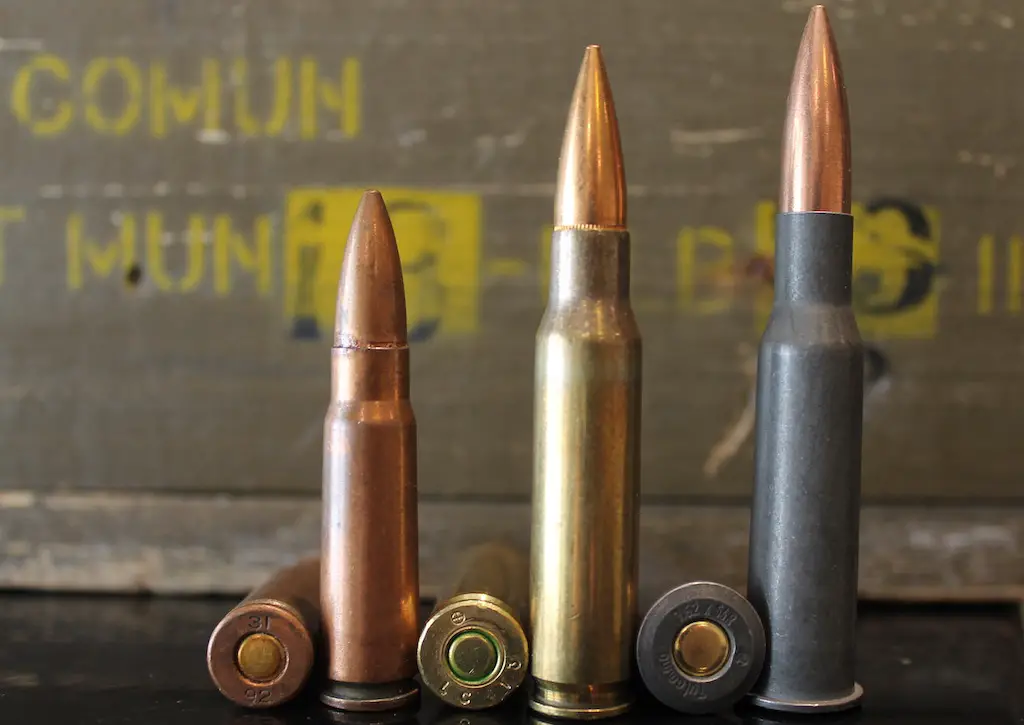
The 7.62x54R is the largest and the 7.62x39mm is the smallest cartridge in terms of case length, overall length, rim diameter, and case capacity. However, the 7.62×39 and 7.62×54 both have the same bullet diameter.
Additionally, the 7.62×51/.308 Winchester and 7.62×39 are rimless cartridges while the 7.62x54R is a rimmed cartridge.
Finally, while all three are standardized by the Permanent International Commission for the Proof of Small Arms (better known as CIP), only the 7.62×39 and .308 Winchester are also SAAMI cartridges. When compared using their CIP ratings, we can see that the .308 Winchester has the highest maximum authorized pressure of the bunch (60,190psi compared to 56,565psi for the 7.62x54R and 51,488psi for the 7.62×39).
Note: while the case capacity figures listed below do give a good indication of the differences between the three cartridges, exact case capacities vary slightly according to the brand of brass used.
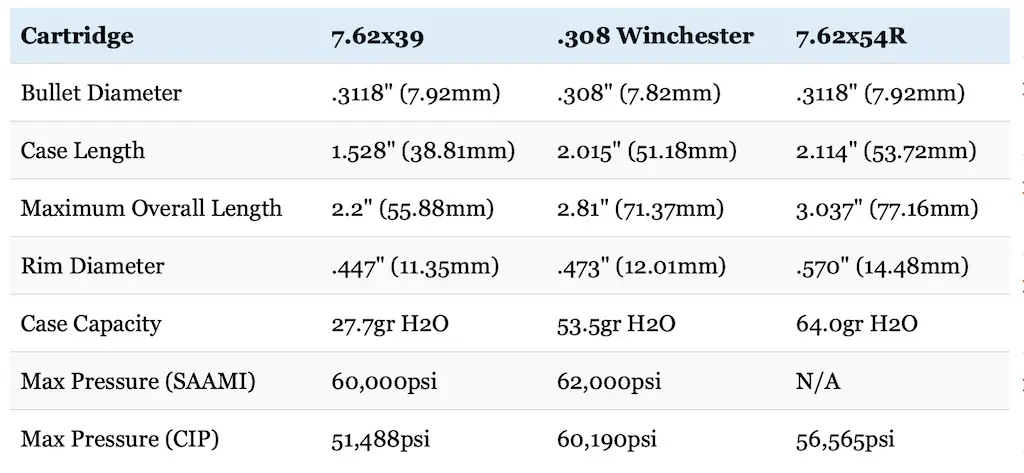
7.62×39 vs 308 vs 7.62x54R Ballistics
Just like you’d probably expect from the fact that they have such vastly different external dimensions, there are some big differences in the ballistics of the 7.62x39mm, .308 Winchester, and 7.62x54R as well.
The table below compares a 123gr Hornady SST (.295 BC) load in 7.62x39mm to a 150gr Winchester Deer Season XP (.392 BC) load in .308 Winchester and a 150gr SPBT (.354 BC) load by PPU in 7.62x54R. This data is for Hornady, Winchester, and Prvi Partizan factory ammo using a 200 yard zero.
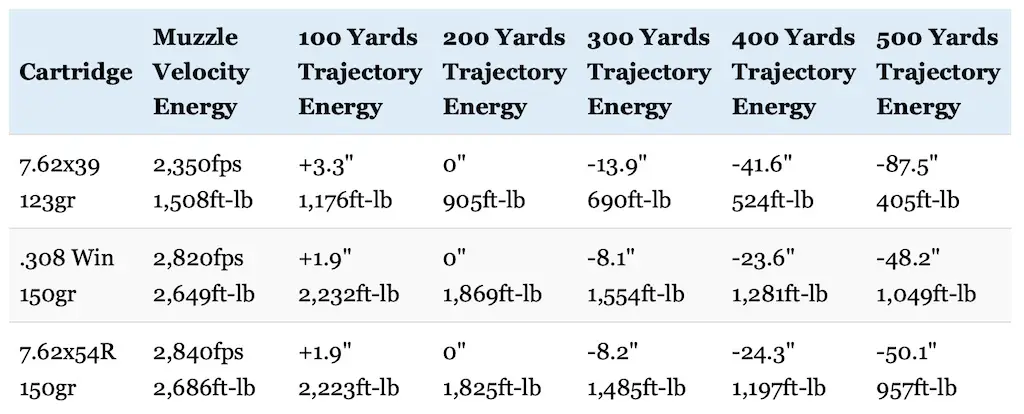
Not surprisingly, the 7.62x39mm shoots the lightest bullet, with the lowest ballistic coefficient, at the slowest velocity. That’s why it has the least kinetic energy and the most arching trajectory of the bunch.
The 150gr loads for the .308 Winchester and 7.62x54R both have very similar external ballistics, but the .308 has a slightly flatter trajectory and retains a little bit more energy at longer range because it fires a bullet with a higher ballistic coefficient.
Those same characteristics are further demonstrated by the range at which each load goes subsonic: 575-600 yards for the 7.62×39, 875-900 yards for the 7.62x54R, and 975-1,000 yards for the .308 Winchester.
The chart below compares how much a 10 mile per hour crosswind impacts those same three loads out to 500 yards.
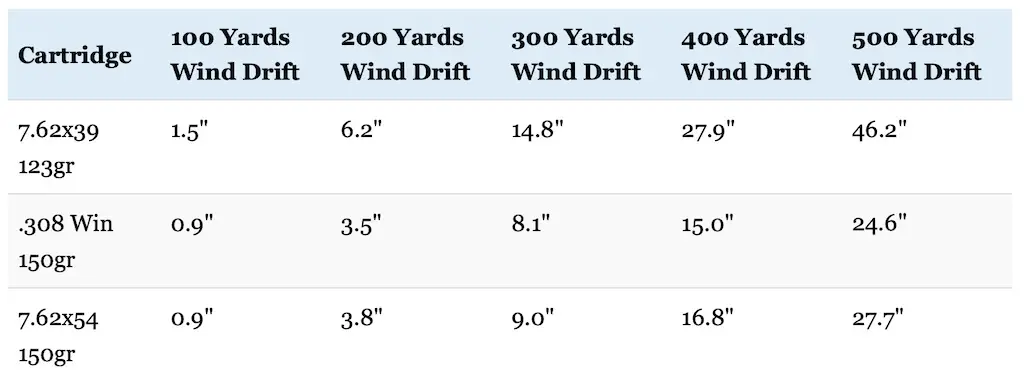
The 7.62x39mm bullet has by far the most wind drift and is pushed nearly two feet further off target than the .308 Winchester load at 500 yards. The .308 Winchester and 7.62x54R bullets have virtually the same amount of wind drift, with the .308 load having a little bit more resistance to the wind due to the higher BC of that bullet.
Now let’s talk about recoil.
The table below compares those same three loads when fired from rifles of a similar weight: an SKS for the 7.62×39, a Savage MSR 10 for the .308 Winchester, and a M91/30 Mosin-Nagant for the 7.62x54R.
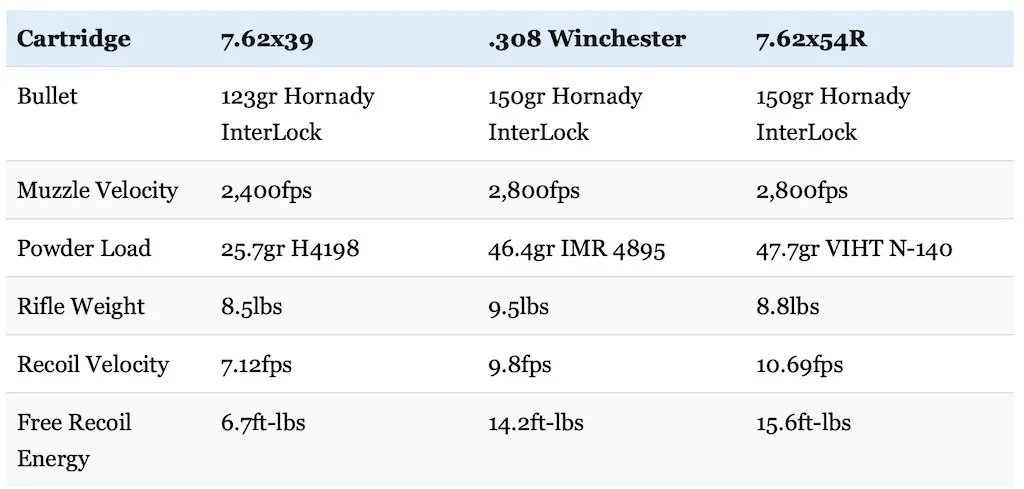
Felt recoil will vary from shooter to shooter and rifle to rifle, but free recoil energy is still a useful way to compare cartridges.
The 7.62x54R has a reputation for fierce recoil, but it only has about 10% more free recoil energy than the .308 Winchester in this particular case. When you think about it, that makes perfect sense: both loads being compared are shooting the same weight bullet at the same velocity, but the 7.62x54R load uses a little bit more powder and the .308 Winchester load is fired from a heavier rifle. Those factors combine to result in less recoil energy for the .308 compared to the 7.62x54R.
So, while the 7.62x54R isn’t a light recoiling cartridge by any reasonable standard, this is a good demonstration of how other factors besides free recoil energy can impact felt recoil. In the case of the 7.62x54R, much of the cartridge’s reputation can likely be attributed to some combination of a poorly designed/ill-fitting stock and the narrow metal butt plate on the typical Mosin-Nagant rifle.
Adding a larger and thicker aftermarket recoil pad will do a lot to reduce the felt recoil of a Mosin-Nagant. Additionally, keep in mind that the relatively heavy weight of the Mosin-Nagant does a lot to dampen recoil and, all other things equal, a lighter rifle (like an M38 or M44 Nagant Carbine) will have more recoil than a heavier rifle. By the same token, a load firing a heavier bullet will (all other things equal of course) have more recoil than a different load shooting a lighter bullet.
At the same time, the 7.62x39mm has less than half the free recoil energy of the 7.62x54R and the .308 Winchester (which essentially packs the power of WWII era .30-06 loads into a smaller case). This fits with the original intent of the engineers who were trying to build a mild shooting and easy to handle cartridge that was still powerful enough for work at short to moderate range.
So where do we stand with each cartridge?
While it’s in a different league from modern heavy hitters like the .300 Win Mag and 7mm Rem Mag, the 7.62x54R is a very powerful and relatively flat shooting cartridge, especially considering how old it is. Recoil is a little on the heavy side, but it’s more or less on par with the .30-06 Springfield.
It’s also clear that the designers of the 7.62x39mm succeeded in their goal of building an “intermediate cartridge” with much less recoil than full-powered rifle cartridges of the day, but still quite a bit more powerful than a pistol cartridge. Roughly comparable to the .30-30 Winchester, the 7.62x39mm performs very well at ranges inside 300 yards and the moderate recoil of the cartridge facilitates rapid follow-up shots, but performance significantly drops off at longer range.
The .308 Winchester is very similar to the 7.62x54R in many ways. However, since .30 caliber cartridges like the .30-06 and .300 Win Mag are so popular in North America, users of the .308 Winchester benefit from the extensive the research and development that has gone into refining .308″ bullets within the United States over the last century.
For this reason, shooters using a .308 Winchester have a wide range of bullet weights and models to choose from. These projectiles quite often take advantage of the latest developments in bullet development and offer advantages in precision, terminal performance, and ballistic coefficient compared to the bullets used by the 7.62×39 and 7.62x54R.
7.62x39mm factory loads typically use bullet weights in the 120-125 grain range, with 122 and 123 grain bullets being the most common. 7.62x54R factory loads most often use 147-203 grain bullets and 148, 150, and 180 grain bullets are the most popular. Finally, typical .308 Winchester factory loads use bullets in the 110-180 grain range. 150 grain, 165 grain, 168 grain, and 180 grain bullets are the most common.
Additionally, most of the ammo options for the 7.62×39 and 7.62x54R use FMJ bullets and there are only a handful of soft point loads suitable for hunting for those cartridges. On the other hand, there is an incredible variety of high quality .308 Winchester ammo manufactured for competition shooting, hunting, and general plinking.
In that same vein, the .308 Winchester has seen extensive use in sniper rifles as well as during practical and/or long distance shooting competitions and is known for being a very accurate cartridge. While both the 7.62x54R and especially the 7.62×39 have have reputations for mediocre or even poor accuracy, this can usually be attributed to using low quality military surplus ammunition and/or rifles. Both cartridges are capable of very good accuracy when good ammunition is used in an accurate rifle, but neither can hold a candle to the .308 Winchester in that regard.
If you’d like to learn more about the accuracy of the .308 Winchester and how it compares to cartridge purpose built for long range competition shooting, read this article:
6.5 Creedmoor vs 308 Winchester Debate Settled
7.62×39 vs 308 vs 7.62x54R: Ammunition Selection
The 7.62×39, .308 Winchester, and 7.62x54R are all relatively popular hunting cartridges and ammo availability is generally not an issue during normal times. However, the .308 Winchester is by far the most widely used. The 7.62×39 is a distant second, but both usually still rank among the Top 10 in ammunition sales in the USA each year. The 7.62x54R has a pretty large base of dedicated users, but is nowhere near as popular as the other two in North America.
Since it’s one of the most popular centerfire rifle cartridges in the world, virtually every big ammunition manufacturer like Aguila, Barnes, Black Hills, Browning, Federal Premium, Hornady, Magtech, Nosler, PMC, Prvi Partizan, Remington, Sellier & Bellot, Sierra, Speer, Swift, and Winchester produces a variety of quality .308 Win factory ammunition suitable for hunting.
As previously stated, most of the highly regarded bullet types specifically designed for big game hunting are available in .308 as well like the Barnes TTSX, the Hornady ELD-X, GMX, InterLock, and SST, the Nosler AccuBond, E-Tip, and Partition, the Remington Core Lokt, the Sierra GameKing, the Swift A-Frame and Scirocco, and the Winchester Power Point.
On the other hand, there aren’t nearly as many commercial ammo options for the 7.62×39 or 7.62x54R. Brown Bear, Tula, and Wolf make lots of inexpensive plinking ammunition while Prvi Partizan, Sellier and Bellot, and Silver Bear all make soft point hunting ammunition both cartridges. Additionally, Hornady and Nosler produce 7.62x39mm hunting ammo for use on varmints and big game.
Prices and availability vary, but ammunition for all three cartridges is widely available. The .308 Winchester has the widest variety of ammunition, to include a good selection of match ammo, but .308 ammo tends to be the most expensive. Run of the mill steel case 7.62x54R ammunition is much less expensive and 7.62×39 ammo can be even cheaper.
BUY SOME EXCELLENT 7.62x39mm AMMO HERE
BUY SOME REALLY GOOD 308 WINCHESTER AMMO HERE
BUY SOME GREAT 7.62x54R AMMO HERE
If you’d like to learn more about some of the various hunting ammunition choices for the 7.62×39 and 308 Winchester, read these articles:
Best 7.62×39 Ammo For Hunting Deer & Other Big Game
Best 308 Ammo For Hunting Deer & Other Big Game
Reloading components for all three cartridges are also obtainable, but the .308 Winchester is by far the easiest one to reload. Since it uses the same .308″ diameter bullet as other popular .30 caliber cartridges (like the 30-06, 300 RUM, .300 Win Mag, and 300 PRC), there are plenty of bullets of various weights and styles to choose from. Depending on the exact rifle in question, the 7.62×39 and 7.62×54 use bullets ranging in size from .308 all the way up to .312. Those larger bullet sizes are not nearly as common as .308 bullets, but they’re out there if you look hard enough.
At the same time, a lot of 7.62×39 and 7.62x54R ammunition uses Berdan primers, which further complicates handloading for them.
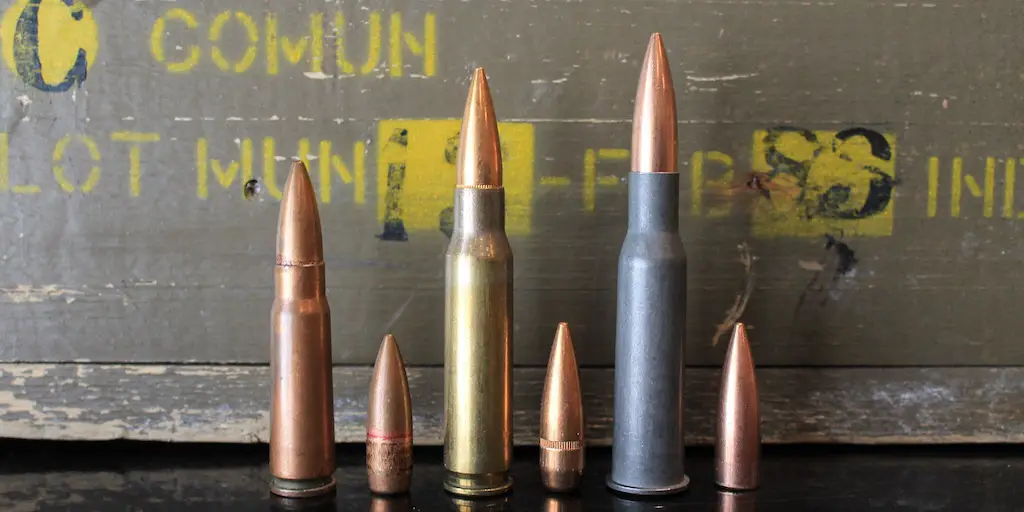
7.62×39 vs 308 vs 7.62x54R: Rifle Selection
Similar to the situation with ammunition, rifle availability is uneven in these three cartridges. .308 rifles are the most common in the United States followed by the 7.62×39 and the 7.62x54R. While there is a bigger variety of .308 Winchester rifles, there are still large numbers of rifles chambered in each cartridge, so finding a good deer rifle shouldn’t be an issue regardless of which one you choose.
Limited numbers of SVT-40, Dragunov (SVD), PSL, and other semi-automatic 7.62x54R rifles are available. However, with over 37,000,000 produced, the different versions of the Mosin-Nagant make up the vast majority of 7.62x54R rifles. Of these, the M91/30 is the most common, but there are still large numbers of M38 and M44 carbines along with some Model 1891 and Model 1891/59 carbines out there.
Finnish military and several Warsaw Pact/Eastern bloc countries produced their own versions of the Mosin-Nagant for many years as well. Remington and New England Westinghouse even produced thousands of Nagant military rifles for Russia during World War I. Finally, Winchester also manufactured their lever-action Model 1895 in 7.62x54R. All of these rifles are obtainable to a certain degree in North America.
The .308 Winchester is pretty easy to find in semi-automatic sporting rifles like the AR-10 and M1A as well as surplus FN-FALs and HKs. There are a few AR-15 variants chambered in 7.62×39, but they aren’t especially common. That being said, the 7.62×39 is very popular in a large number of AK clones.
While the 7.62×39 is produced in a few bolt action rifles like the CZ 527 and the Ruger American Ranch rifle, it’s not nearly as common as the .308 Winchester. The Winchester cartridge is produced in virtually every popular bolt action rifle like the Browning X-Bolt, Kimber Hunter, Mossberg Patriot, Nosler M48, Remington 700, Ruger Hawkeye and American, Savage Axis, Weatherby Vanguard, and Winchester Model 70.
BUY A REALLY NICE 7.62x39mm RIFLE HERE
BUY A QUALITY 308 WINCHESTER RIFLE HERE
7.62×39 vs 308 vs 7.62x54R: Which Is Right For You?
The 7.62×39, the .308 Winchester, and the 7.62x54R are all well suited for hunting medium game like feral hogs, mule deer, whitetail deer, black bear, or fallow deer at short to moderate range. The .308 Winchester has a small, but definite advantage over the others here because of its generally better accuracy and larger selection of quality hunting bullets.
That being said, they will all work for hunting deer sized game out to 200 yards or so with good shot placement and when using quality bullets.
Make no mistake though: a bullet through the vitals from any of these cartridges will make short work of almost any game animal.
Do you primarily hunt medium sized game like feral hogs, black bear, or deer at ranges within 200 yards? All three will quickly and ethically kill deer sized game with good shot placement and there isn’t much difference between them at short range. Go with the .308 Winchester if you want the easiest to find hunting ammo or the 7.62×39 if you’re particularly sensitive to recoil.
Do you want a cartridge well suited to hunt bigger animals like kudu, eland, elk, moose, caribou, or red stag with during an Africa, Canada, or New Zealand hunting expedition? The 7.62x54R and .308 Winchester are both more than powerful enough to ethically take down really big game animals, but I’d lean toward getting a bolt action rifle in .308 due to the fact that it has an advantage with the better variety of high quality hunting rifles and bullets available for the cartridge.
Are you sensitive to recoil? Go with the 7.62x39mm cartridge. It’s still powerful enough to ethically take deer sized game at short range, but has much less recoil than the other two cartridges.
Do you want a battle rifle for self-defense, home defense, or for a real world SHTF situation? Go with the 7.62×39 if you want an AK style rifle, are sensitive to recoil, or are on a more limited budget. Otherwise, I’d personally say a rifle in .308 Winchester is a better option, but it’s really a matter of personal preference because they’ll both work very well.
Are you looking for a cartridge with lots of inexpensive ammo for general plinking or target shooting? Though .308 Winchester ammo is pretty common, the 7.62x54R and especially the 7.62x39mm are usually much less expensive in the United States.
The 7.62x39mm, .308 Winchester, and 7.62x54R are all very solid rifle cartridges, but they have different strengths and weaknesses that reflect the priorities of those who designed them. Though the differences between the cartridges (7.62×39 vs 308 vs 7.62x54R) are pretty significant in some respects, all three cartridges are still suitable for a pretty big range of hunting tasks.
Get a nice hunting rifle chambered in the cartridge that you think fits your needs the best, learn to shoot it well, use quality bullets, and you’ll be well prepared for most common hunting situations.
Enjoy this article about the 7.62×39 vs 308 vs 7.62x54R debate? Please share it with your friends on Facebook and Twitter.
The Lyman 50th Edition (p241-245, p270-271, & p272-273), and Hornady 10th Edition (p474-488, p489-497, p618-621) reloading manuals were also used as references for the history of the cartridges and provided data to compare their size and recoil. Ballistic data for original 7.62x51mm, 7.62x39mm, and 7.62x54R military cartridges were obtained from Inetres and Ballistic Studies. The data used to compare the trajectory of the cartridges was obtained from Hornady, PPU, and Winchester. Maximum pressure obtained from SAAMI (p24 and p31) and CIP (here, here, and here). Case capacities were obtained from Chuck Hawks, Kwk.us, and Nosler. I used the Hornady Ballistic calculator and ShootersCalculator.com to compare wind drift, the range each bullet goes subsonic, and recoil for the cartridges.
Make sure you subscribe to The Big Game Hunting Podcast and follow The Big Game Hunting Blog on Facebook, Instagram, Twitter, and YouTube.
NEXT: 300 BLACKOUT vs 7.62×39: EVERYTHING YOU NEED TO KNOW
John McAdams is a proficient blogger, experienced shooter, and long time hunter who has pursued big game in 8 different countries on 3 separate continents. John graduated from the United States Military Academy at West Point and is a veteran of combat tours with the US Army in Iraq & Afghanistan. In addition to founding and writing for The Big Game Hunting Blog, John has written for outdoor publications like Bear Hunting Magazine, The Texas State Rifle Association newsletter, Texas Wildlife Magazine, & Wide Open Spaces. Learn more about John here, read some of John’s most popular articles, and be sure to subscribe to his show: the Big Game Hunting Podcast.


Another good write up. John always offers practical and useful information. I particularly like his charts! Sure there are plenty of sites to get various ballistics and load/bullet selection info. But this site gives good information without being too much. If your not in the mood to read a short story this is a great site.
Since the PSL was offered in 7.62×51, I’d love to know where can I find a PSL bolt in .308!
That’s a darn good question. Unfortunately, I have no idea where you can find a .308 PSL bolt.
Sorry I couldn’t be of more help.
John
Very enlightening.
Nice article. I’m not sure if the answer is in there though- I have a 308 hunting rifle and want to know if it is safe to use 7.62×51 nato ammo for plinking. For hunting I use Nosler or Hornady 308. Thanks.
Hi Dennis. Glad you enjoyed the article.
To answer your question: yes, you can safely shoot 7.62x51mm NATO ammo in a .308 Winchester rifle.
John
Correct 100%. However, shooting .308 in some military 7.62×51 may exceed the pressure allowed.